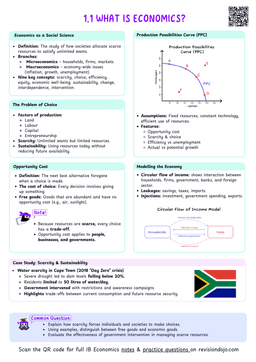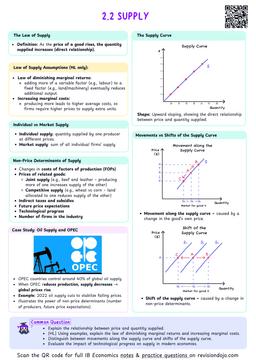Factors of production: land, labour, capital and entrepreneurship
Factors of production
All resources or inputs used to produce goods and services.
There are many different factors of production, but they can be categorised in 4 main groups:
- Land: including all the natural resources above or below the ground.
- Labour: the work done by people.
- Capital: equipment used in producing goods and services.
- Entrepreneurship: willingness to take a risk to make a profit.
Land
Land
All natural resources on Earth, including farmland and non-farmland. All the natural resources found below and above the ground.
Despite land being a vast source of resources, most of the resources that fall into the land category are scarce (non-renewable):
- Natural gas, oil, coal, and fossil fuels are limited.
- Materials such as wood or mined minerals will eventually run out.
- Animals found in the area have to be used at a rate lower than their reproduction rate.
However, there are also some renewable resources which are virtually unlimited (humans utilising them doesn't lead to their depletion).
- Air can be used to obtain energy through windmills without reducing the amount of air available.
- Sun energy is a constant source of energy.
The resources contained in a square kilometer of land are many: the trees on it, the minerals underground, the air and sunlight on top of the ground... All of these land resources can be utilised as factors of production.
Labour
Labour
All the physical work and mental skills that humans put into the production of goods and services.
It is important to understand that only the efforts allocated to producing goods and services count as labour:
- The effort of a person working at a factor is labour.
- Dedicating time to think of new ideas for sustainable city transportation is labour.
- The effort of running to catch the bus or playing video games are not labour: the effort is not allocated to producing goods or services.
Capital
Capital
Human-made factors of production used to produce goods and services.
For a factor of production to be considered as capital it must:
- Be human-made. Natural resources are not capital resources because they are a product of nature.
- Be used to produce goods and services. A basketball is man-made but is not used to produce goods and services (assuming they are not the ones used in the NBA, which in that case are used to produce a service). However, the machines and factories in which used to make the ball are capital resources.
There are 3 different types of capital factors of production:
- Physical capital: used to produce more goods and services in the future.
- Human capital: human skills and resources acquired by people to be more productive.
- Financial capital: investments and funds.
Physical Capital
Physical capital
Capital factors of production used to produce more goods and services in the future.
The factory and machines a car-producing firm owns is an example of physical capital factors of production: the company uses them to produce goods (cars).
Human Capital
Human capital
Skills, abilities, good health, and knowledge utilized by people to increase their productivity.
A teacher’s education and classroom experience are examples of human capital: they use their knowledge and skills to effectively teach students.
A construction worker’s strength and good health are examples of human capital: they enable the worker to perform physically demanding tasks safely and efficiently.
Financial Capital
Financial capital
Investments in financial instruments, or the funds used to purchase financial instruments. A capital factor of production.
The factors of production considered as financial capital are:
- Investments in financial instruments: stocks and bonds.
- The funds used to purchase financial instruments (money).
A company’s investment in stocks or bonds is an example of financial capital: it uses the funds to raise money for expansion or operations, both leading to higher production of goods and services.
Entrepreneurship
Entrepreneurship
The unique human skills held by some individuals, including the ability to innovate, take business risks, and pursue new opportunities for running a business.
Entrepreneurship is a factor of production (resource) possessed by some people: entrepreneurs. It is a factor of production because:
- Entrepreneurs establish and manage businesses by utilizing the available factors of production.
- The management carried out by the businesses created by entrepreneurs is used to produce goods and services.
Entrepreneurship tends to be a highly-rewarded skill due to the risk entrepreneurs accept. If their businesses fail, they risk losing significant amounts of money; however, if they succeed, the reward for their risk are the profits.
ExampleAn entrepreneur starts a local coffee shop by combining labor, land, and capital. They take the risk of investing in equipment and a storefront, hire staff, and offer a unique menu. If the business thrives, they earn profits as a reward for their innovation and risk-taking.
Scarcity
Unlimited human needs and wants to be met by limited resources
In the previous section we introduced the idea that scarcity is the foundation of economics.
- Because resources are finite, yet human needs and wants are infinite.
- This imbalance forces individuals, firms, and governments to make choices about how to allocate resources effectively.
The idea that economics arises due to the fact that the scarcity of the factors of production prevents all our unlimited human needs and wants to be satisfied is crucial to understand.
Needs and wants will be mentioned often throughout this book, so it is important to understand their differences:
- Needs are essentials required for survival, such as food, water, and shelter.
- Wants are additional desires that go beyond survival, like luxury cars or vacations.
Scarcity of resources being unable to satisfy all needs and wants
A government may need to decide between funding a new hospital (a need) or hosting a major sports event (a want). Limited resources mean it cannot do both without trade-offs. Studying the outcomes of the choice the government must make is part of the study of economics.
Scarcity and Sustainability
Sustainability
Using resources in a way that meets current needs without compromising the ability of future generations to meet their own needs.
- Because resources are scarce, consuming them at rates faster than their generation will eventually lead to their depletion.
- Hence, humans should ensure resources are consumer sustainably.
- If resources are used unsustainably, the scarcity of the factors of production of future generations will be higher, and so future generations will have to sacrifice more human needs and wants.
Imagine you own a forest of 100 trees. If every year you cut down 20 trees for wood usage and only plant 10 trees, in 10 years you will run out of tress and will be unable to satisfy your wood-related needs and wants.
However, if every year you cut down 20 tress but also plant 20 trees, you will never run out of trees. By following consuming your factors of production at a sustainable rate, you are not harming your future ability to satisfy your need and wants.
Opportunity Cost
Opportunity cost
The value of the next best option that must be forgone or sacrificed in order to acquire something else.
- The trade-off described in the above example illustrates an opportunity cost.
- An opportunity cost is what you give up when you choose to allocate your scarce resources to do something else.
If you choose to go to the cinema, your choice has an opportunity cost: sacrificing buying two coffees (each one costs \$5). The \$10 that you spend on the cinema ticket could have been allocated to buying two coffees. By choosing to go to the cinema, you have traded-off having two coffees.
Opportunity cost is a fundamental concept in economics that helps achieve a more efficient use of scarce resources.
- Consumers apply it when deciding how to spend their money.
- Producers consider the profits they miss by not producing a different product.


